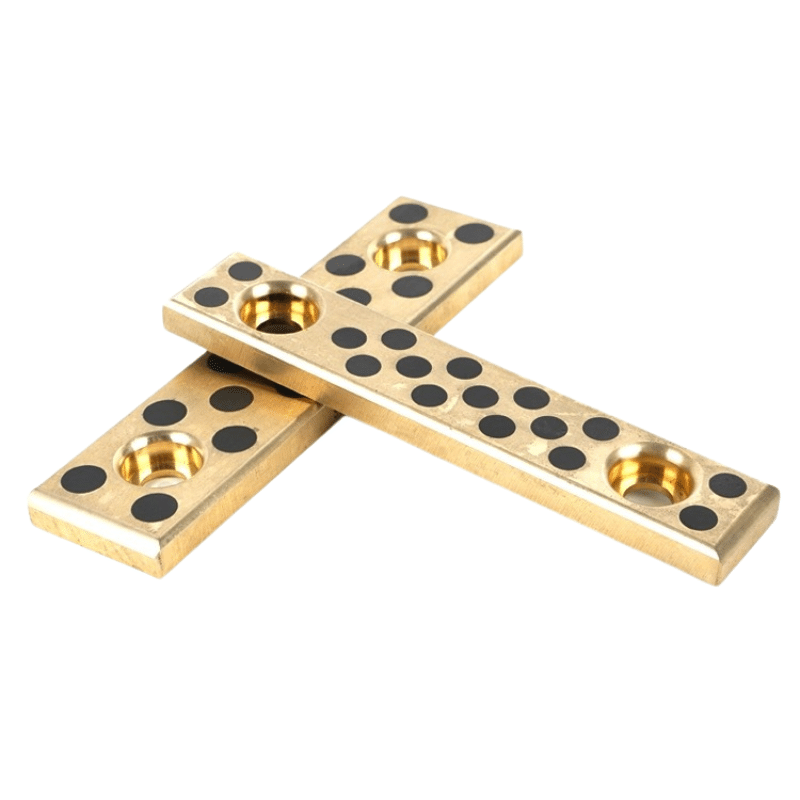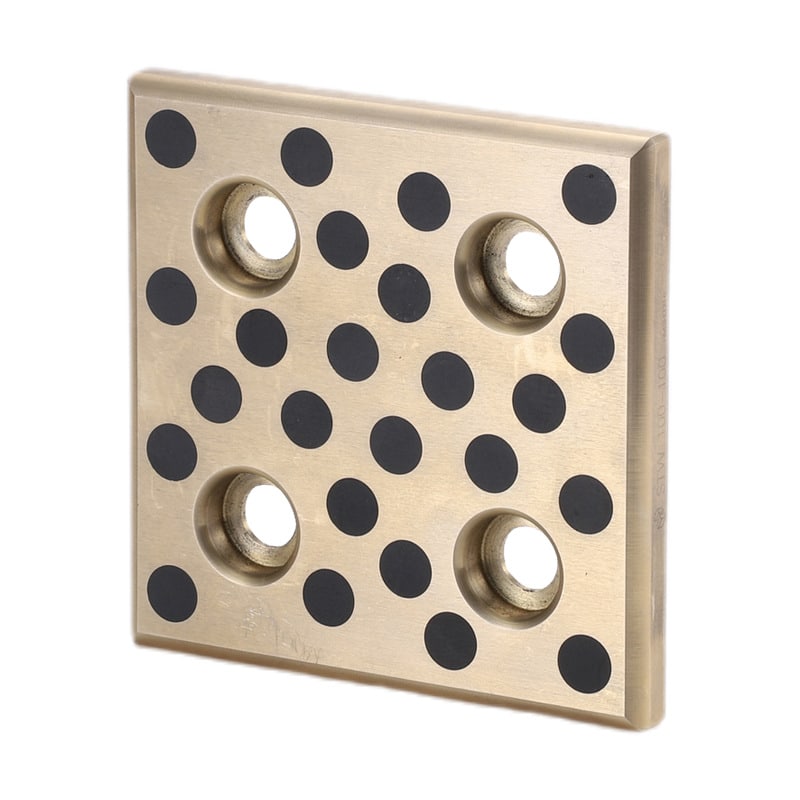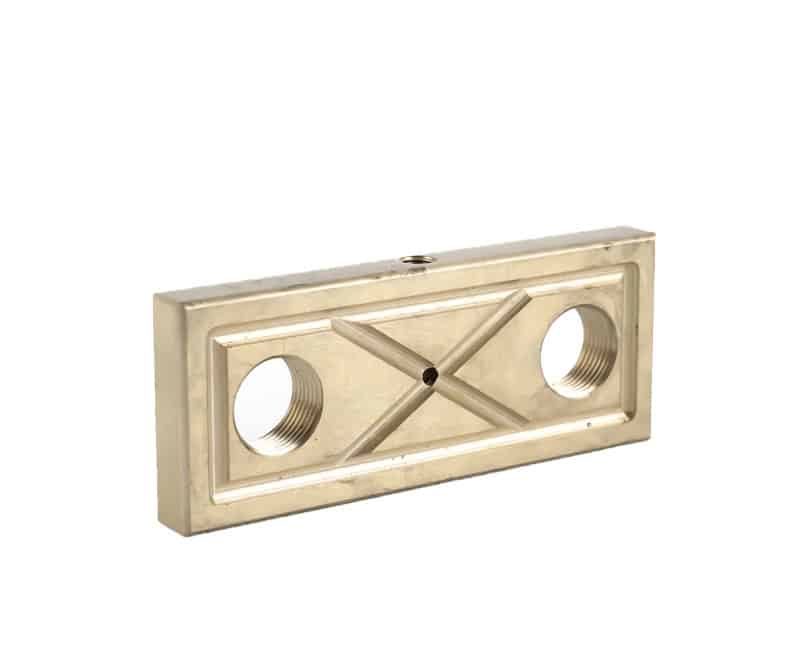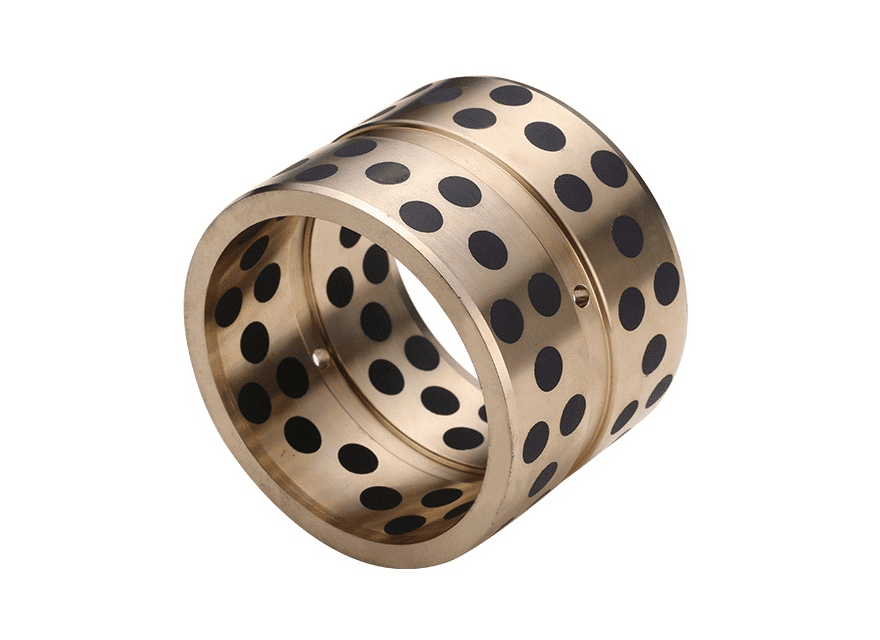CuZn25Al5 high tensile brass Machined Bronze Bearings & Custom Parts
About us
CuZn25Al5 bronze alloy Bushing and bearing, GCuZn26Al4Fe3Mn3 + graphite
CuZn25Al5: This typically refers to a copper-zinc-aluminum alloy containing about 25% zinc and 15% aluminum. This alloy is widely used in the manufacture of bearings due to its high strength and good wear resistance. Product Availability:
CuZn25Al5 is the primary alloy used in all our stock products. Should you require a different alloy, we are able to provide most alloys and can accommodate special sizes according to your specifications.
This bearing is constructed from extra hard and durable bronze and incorporates built-in self-lubricating graphite plugs for maintenance-free operation. It is particularly suitable for high-load applications with limited movement where conventional lubrication is challenging. The graphite plugs, covering approximately 25-30% of the bearing surface, are strategically positioned to ensure continuous lubrication across the entire bearing surface. Various designs of WF sliding elements are available, and custom versions can be crafted in different alloys to suit specific requirements.
Lubrication: While the bearing is maintenance-free, applying lubricants such as greases or oils to the sliding surfaces during assembly is advisable for the initial start-up phase. For best performance and longevity, ensure that mating surfaces are thoroughly cleaned before assembly.
Special Manufacturing: We can provide or manufacture various types of sliding elements based on your needs. Please contact us for more information.
ALLOY CuZn25Al5, Leaded, Phosphor And Aluminium Bronzes Bearing,
Search Our Material Alloy
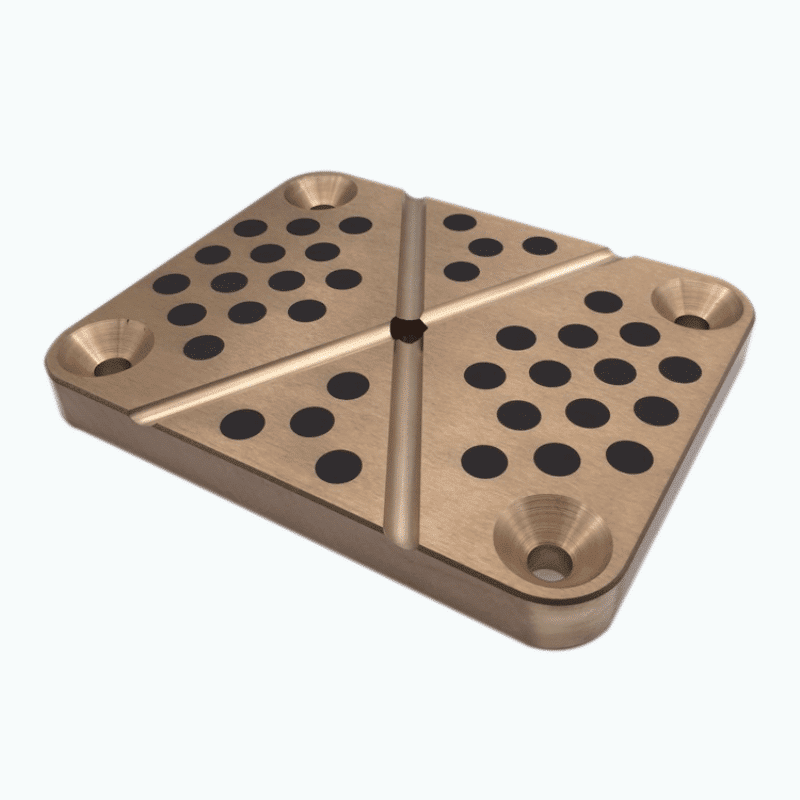
CuZn25Al5, C86300, ASTM, Plain bearing
with graphite plugs, GCuZn26Al4Fe3Mn3
C86300: This is an alloy number by the American Society for Testing and Materials (ASTM), representing a type of leaded brass that typically contains about 2% lead. Leaded brass is used to manufacture various mechanical parts and tools due to its good mechanical properties and machinability.
Water resistant: Indicates that the material has waterproof characteristics, capable of resisting water penetration.
Graphite plugging is a critical feature in these bearings. Graphite is a solid lubricant known for its ability to withstand high temperatures and maintain its lubricative qualities under heavy loads. In the context of bronze bearings, graphite plugs are inserted into the bearing surface. These plugs release small amounts of graphite during operation, which provides continuous lubrication and reduces the coefficient of friction. This self-lubricating feature is particularly valuable in applications where maintenance is difficult or where conventional lubricants could contaminate the product.
The CuZn25Al5 alloy’s composition includes copper (Cu), zinc (Zn), and aluminum (Al), with a small percentage of iron (Fe) and manganese (Mn) to improve its mechanical properties and wear resistance.
High strength bearing alloy CuZn25Al5 Application, C86300, ZCuZn25Al6Fe3Mn3
CuZn25Al5 is the primary alloy used in all our stock products. Should you require a different alloy, we are able to provide most alloys and can accommodate special sizes according to your specifications.
High strength bearing alloy: Refers to a bearing alloy with high strength, commonly used in the manufacture of bearings that are subject to high loads.
High fatigue resistance: Indicates that the material has high fatigue resistance, able to maintain performance under repeated loading and unloading conditions. This is crucial for components like bearings that undergo cyclic stress.
Due to their robust nature, these bearings are ideal for heavy-duty applications across various industries, including automotive, aerospace, and marine environments. They are particularly suited for use in machinery that experiences high levels of friction and requires high corrosion resistance. Common applications include pumps, motors, agricultural equipment, and conveyor systems
Not applicable for seawater applications: Means that this material is not suitable for use in seawater environments, possibly due to the salt content in seawater accelerating material corrosion.
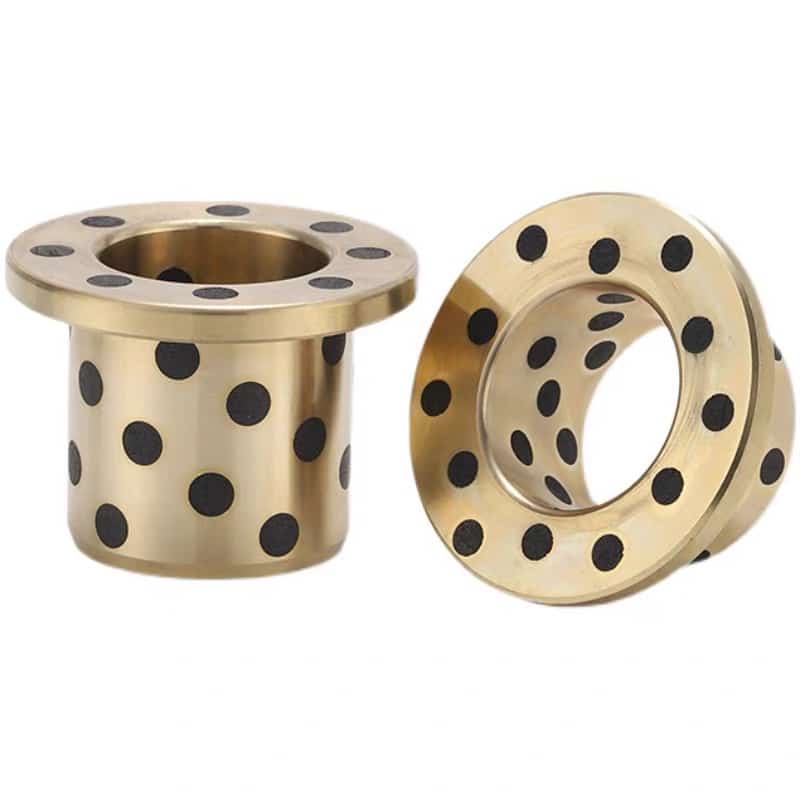
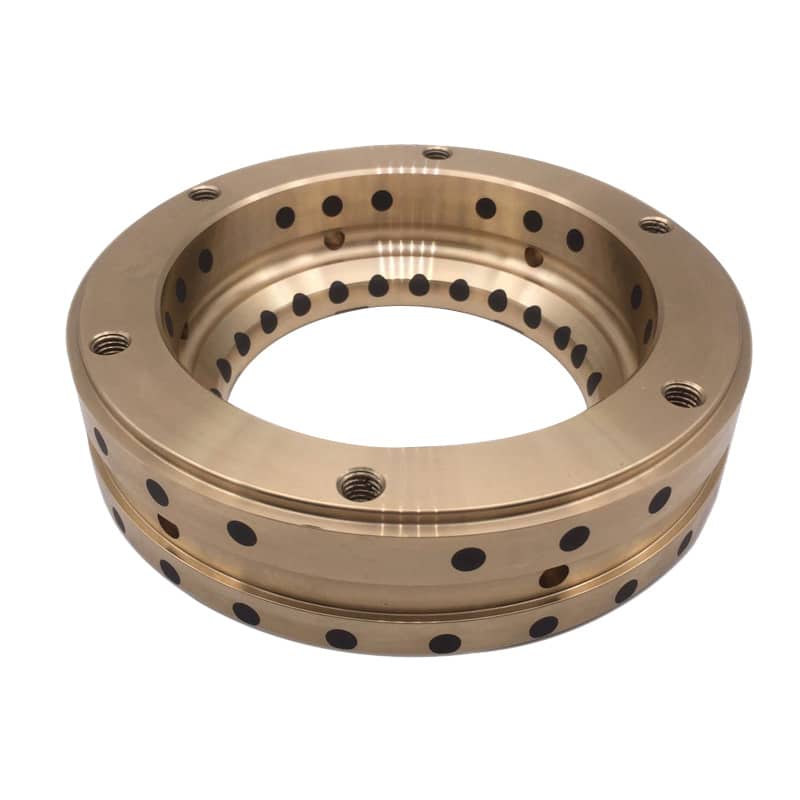
CuZn25Al5 Machined Bronze Bearings, Manufacturing Process: Centrifugal Casting
Solid Lubricants: CuZn25Al5 Machined Bronze Bearings: Refers to machined bronze bearings made from the CuZn25Al5 alloy. Bronze bearings are used in various mechanical systems due to their good wear resistance and load-bearing capacity.
The centrifugal casting process used to manufacture these bearings involves pouring molten metal into a rotating mold. This method ensures a denser and more uniform grain structure in the metal, enhancing the mechanical properties of the finished product. The centrifugal force helps to distribute the metal evenly and to fill intricate molds effectively, which is crucial for achieving the precise dimensions required for bearings
Bronze Wear Plate
Overview of Bronze Wear Plate Products.
Aluminum Bronze C95900 is distinguished by its high aluminum content, ranging between 12 – 13.5%. This composition ensures a product with exceptional strength and hardness. It is ideally suited for applications experiencing heavy loads and abrasive conditions, provided that there is no impact involved.
GB-CuZn25Al5, also known under the DIN 17656-1983 standard, is a high-strength copper-zinc alloy with notable characteristics and applications. Here is a detailed overview:
Chemical Composition
The alloy typically consists of:
- Copper (Cu): 70-75%
- Zinc (Zn): 20-25%
- Aluminum (Al): 4-6%
- Iron (Fe): 2-3%
- Manganese (Mn): 2-4%
This composition provides the alloy with its distinct properties, including high strength and good wear resistance.
Properties
Mechanical Properties
- Tensile Strength: Approximately 655 MPa
- Yield Strength: Around 379 MPa
- Elongation: Typically around 15-25%
- Hardness: Varies depending on the specific processing but generally high
Physical Properties
- Density: Approximately 7.7 g/cm³
- Thermal Conductivity: Moderate, suitable for applications requiring thermal management
- Electrical Conductivity: Lower than pure copper due to the alloying elements
Other Characteristics
- Corrosion Resistance: Good, but can be susceptible to dezincification in certain environments
- Machinability: Fair, with a machinability rating of around 25% compared to free-cutting brass
Applications
GB-CuZn25Al5 is used in various demanding applications due to its high strength and wear resistance:
- Heavy-duty bearings and bushings: Suitable for slow-speed applications with good lubrication
- Hydraulic cylinder components: Beneficial for their durability and strength
- Marine hardware: Utilized for its corrosion resistance and strength
- Gears and worm wheels: Preferred for their wear resistance and mechanical properties
Casting Methods
This alloy can be processed using several casting methods, including:
- Sand Casting: Suitable for large and complex shapes
- Centrifugal Casting: Produces dense and reliable components, especially for cylindrical shapes
- Continuous Casting: Ensures high-quality bars with consistent mechanical properties
Standards and Equivalents
GB-CuZn25Al5 conforms to the DIN 17656-1983 standard and has several international equivalents:
- CuZn25Al5Mn4Fe3-B (European equivalent)
- C86300 (ASTM standard)
- HTB3 (British standard)
Conclusion
GB-CuZn25Al5 is a versatile and high-performance copper-zinc alloy suitable for various industrial applications requiring high strength, good wear resistance, and moderate corrosion resistance. Its specific composition and properties make it an excellent choice for heavy-duty and marine applications.
Available Bearing Forms in Standard Dimensions
- Cylindrical Bushes
- Flanged Bushes
- Sliding Plates
- Thrust Washers
- Flanged Washers
Main Base Alloy
| Phy. Performance. & Chemical Compositions |
CuZn25Al6FeMn3
Bronze Bushing |
CuZn25Al6FeMn3
Bronze Bushing |
CuSn5Pb5Zn5
Bronze Bushing |
CuAl10Ni Bronze Bushing | CuSn12 Bronze Bushing | Cast Iron HT250 |
| Cu% | 65 | 65 | 85 | 80 | 88 | |
| Sn% | 5 | 12 | ||||
| Pb% | 5 | |||||
| Zn% | 25 | 25 | 5 | |||
| Ni% | 5 | |||||
| Al% | 6 | 6 | 10 | |||
| Fe% | 5 | |||||
| Mn% | 4 | 4 | ||||
| Dengity g/cm 3 |
8.0 | 8.0 | 8.8 | 8.3 | 8.8 | 7.3 |
| Hardness | >210 | >180 | >70 | >150 | >80 | >160 |
| Tensile Strength | >750 | >550 | >200 | >500 | >360 | >250 |
| Elongation | >12 | >12 | 15 | >10 | >8 | |
| Coefficient of linear expansion |
1.9·10 -5 /℃ | 1.9·10 -5 /℃ | 1.8·10 -5 /℃ | 1.6·10 -5 /℃ | 1.8·10 -5 /℃ | 1.0·10 -5 /℃ |
| Limit Temp. | 300~400 | 300~400 | 400 | 400 | 400 | 400 |
| Max. Load N/mm 2 | 100 | 80 | 60 | 50 | 70 | 10 |
| Max. Speed m/min | 15 | 15 | 10 | 20 | 10 | 15 |
| Max. PV N/mm2·m/min | 200 | 200 | 200 | 200 | 200 | 40 |
| 400N/mm2 | <0.01 | <0.01 | <0.05 | <0.04 | <0.05 | <0.015 |
Product Features of Self-Lubricated Bronze Bushing Bearings
1. No Oil Supply System Needed
These bearings eliminate the need for oil supply devices, oil holes, and grooves. This simplification reduces the costs associated with the fuel supply system, including processing and assembly, ultimately lowering manufacturing expenses.
2. Reduced Operating Costs
The use of self-lubricating bearings substantially cuts down on the need for lubricating oil and equipment maintenance, while also eliminating the risks associated with oil shortages.
3. Streamlined Design Process
The absence of oil simplifies the design and structure, reducing costs and saving design time. Additionally, using self-lubricating bearings can enhance mechanical properties, extend service life, and improve reliability.
4. Environmental Benefits
With no need for waste oil recycling, these bearings are environmentally friendly, promoting cleaner production practices.
5. Versatile Mechanical Applications
As essential parts of the mechanical industry, these bearings are crucial for normal machine operation. They are designed to withstand high loads and adverse conditions such as foreign body intrusion, extreme temperatures, and imperfect maintenance, which would typically cause galling in general sliding bearings.
Usage Notes
- Where possible, design using standard specifications.
- Ensure there are no foreign bodies in the assembly.
- After use, a solid lubricant may form a black or gray-black film on the sliding surface. Do not scrub this off; it is usual.
- Applying lubricating oil to the grinding parts before assembly can shorten the running-in period, facilitating smoother machinery operation.
- When assembling, press in slowly; avoid hammering to prevent bearing damage and deformation.
- Select appropriate materials for different parts to improve mechanical performance and extend the bearing’s service life.
- For high-load, reciprocating movements, consider using screw fixation.
- In environments like fresh water, seawater, or maritime settings, use stainless steel or surface plating.
C86300, ZCuZn25Al6Fe3Mn3, ALLOY CuZn25Al5 Machined Bearings, CuZn25Al5 embedded Solid Lubricants bearings
Experience the Strength of Self-lubricating Bearings
Bronze Bushing for seawater environments
- Copper-Nickel Alloy (Cu-Ni Alloy): Due to its excellent resistance to seawater corrosion, the use of copper-nickel alloys is expanding in marine and ocean engineering seawater pipeline systems, such as desalination treatment pipelines, condenser tubes, and heat exchangers in marine power plants.
- Nickel aluminum bronze: Nickel aluminum bronze is an alloy that includes elements such as Ni, Fe, and Mn added to aluminum bronze. It exhibits superior properties such as high tensile strength, fatigue resistance to corrosion, seawater corrosion resistance, and resistance to cavitation corrosion in seawater.
- Aluminum Brass: Aluminum brass performs well in terms of corrosion resistance in seawater pipeline materials. The increasing order of corrosion resistance is: steel, galvanized steel, aluminum brass, copper-nickel alloy, and 70-30 copper-nickel alloy.
- Tin Bronze: Studies on the corrosion behavior of tin bronze in deep-sea environments show that it has a relatively low corrosion rate, making it suitable for use in seawater environments.
- Leaded Brass: Although the suitability of leaded brass in seawater environments is not specifically mentioned in search results, leaded brass typically has good mechanical properties and machinability, which may make it suitable for certain non-direct seawater contact parts in marine engineering.
C86300, ZCuZn25Al6Fe3Mn3, Need Bearings That Last? Solid Lubricated Bronze Bearings Material
When selecting copper alloy bearings suitable for seawater environments, it is necessary to consider the alloy’s corrosion resistance, strength, fatigue resistance, and machinability. Given the characteristics of seawater environments, such as high salinity, pressure, and temperature fluctuations, the chosen copper alloy must be able to withstand various forms of corrosion present in seawater, including galvanic corrosion, crevice corrosion, stress corrosion cracking, and erosion corrosion.
Please note that while some copper alloys exhibit good corrosion resistance in seawater, the specific choice of material should be based on the working conditions in the actual application, cost-effectiveness, and availability. Additionally, appropriate design, corrosion prevention measures, and maintenance should also be considered.
Superior C86300, ZCuZn25Al6Fe3Mn3 Bronze Bearings Here! CuZn25Al5 + graphite with Built-in Solid Lubricant, graphite embedded wear bushings and plates
The Centrifugal Casting CuZn25Al5 Oilless Bronze Bearing with graphite is a specialized type of bearing that combines the properties of the CuZn25Al5 bronze alloy with the added benefit of graphite plugs. This combination enhances the bearing’s self-lubricating capabilities, making it particularly effective in reducing friction and wear in various industrial applications.

